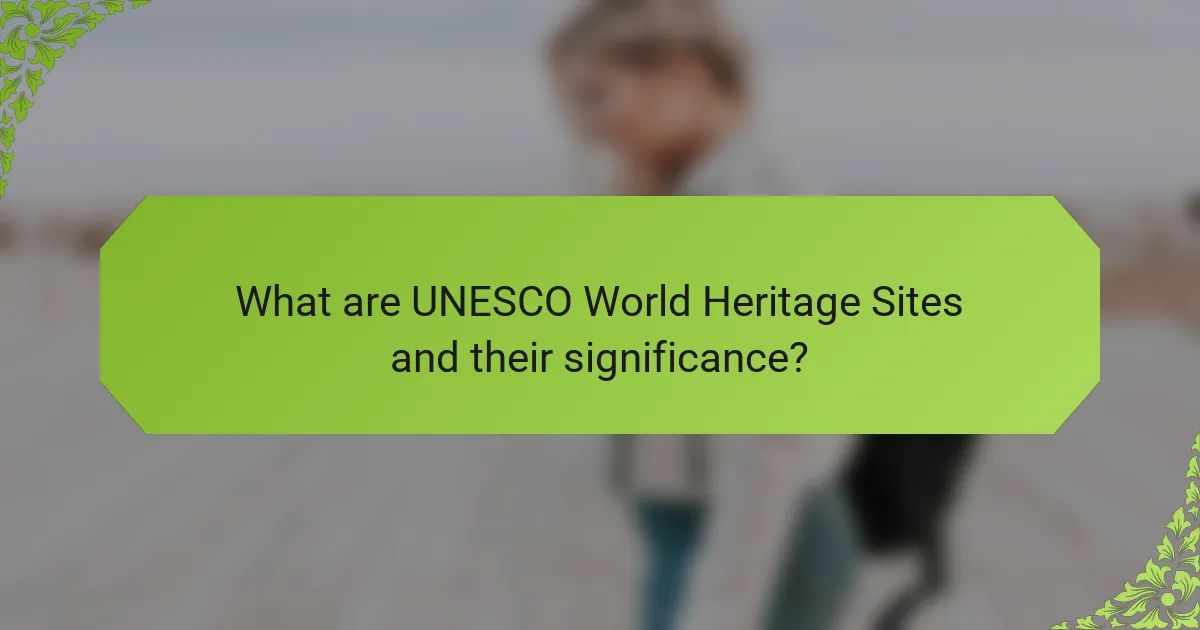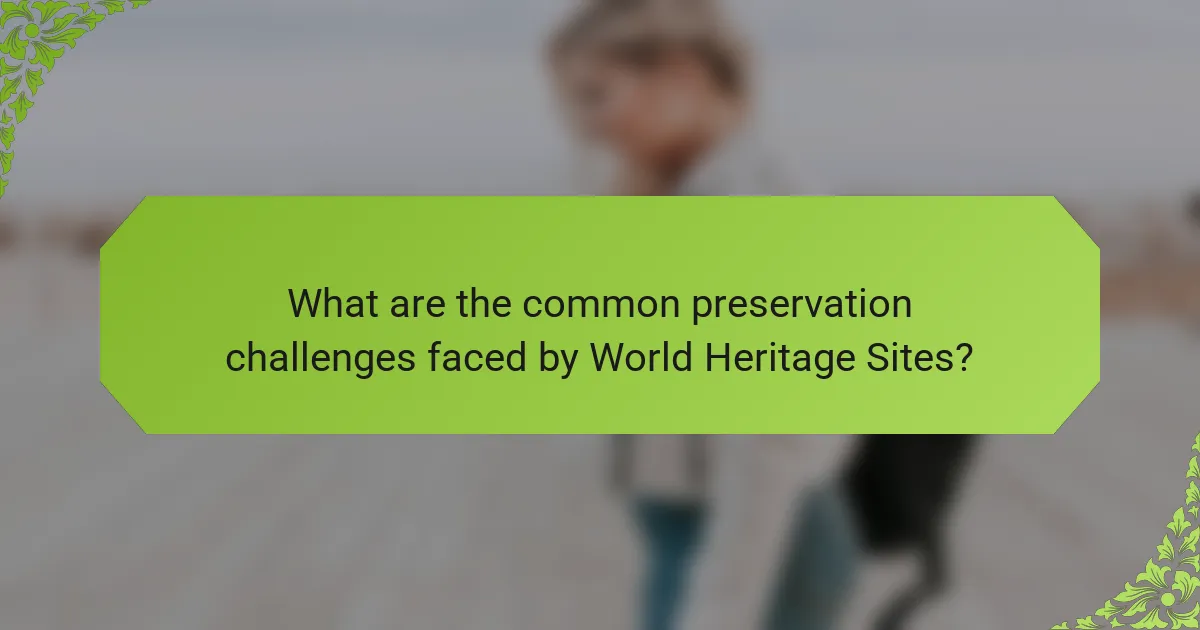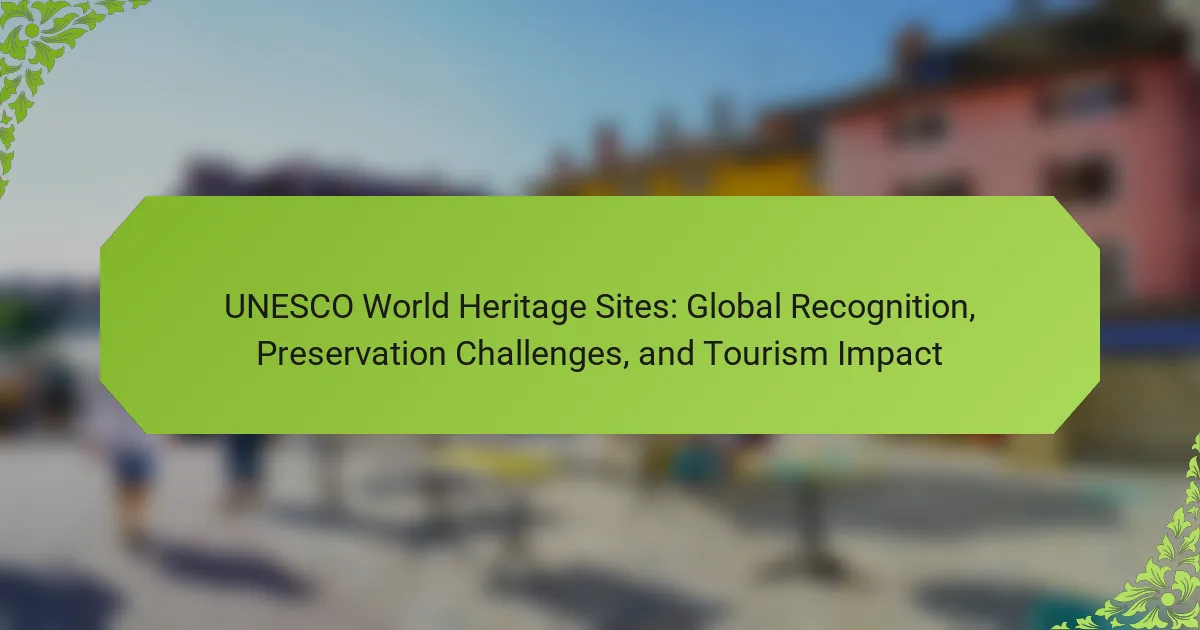UNESCO World Heritage Sites face significant preservation challenges amid increasing urbanization and climate change. These globally recognized locations promote conservation and international cooperation while attracting substantial tourism. Balancing the economic benefits of visitor engagement with the need for sustainable management is crucial. Effective strategies involve community involvement, regulatory measures, and adaptive practices to protect these invaluable cultural and natural treasures.

What are UNESCO World Heritage Sites and their significance?
UNESCO World Heritage Sites are globally recognized locations deemed significant for their cultural, historical, or natural importance. Their significance lies in promoting conservation, fostering international cooperation, and enhancing tourism. These sites face preservation challenges due to urbanization, climate change, and inadequate funding. As a result, they often rely on local communities and global support for sustainable management. The tourism impact can be substantial, providing economic benefits while also raising concerns about over-tourism and environmental degradation.
How does UNESCO select sites for World Heritage status?
UNESCO selects sites for World Heritage status based on criteria that assess cultural and natural significance. The evaluation process involves expert recommendations, national nominations, and rigorous assessments by advisory bodies. Key criteria include outstanding universal value, authenticity, and integrity. Each site undergoes comprehensive evaluations to ensure it meets these standards, balancing preservation needs with tourism impacts.
What criteria must sites meet for inclusion?
To be included as a UNESCO World Heritage Site, locations must meet strict criteria, including outstanding universal value, authenticity, and integrity. They should represent a masterpiece of human creative genius or significant cultural exchange. Additionally, sites must have adequate legal protection and management to ensure their preservation.

What are the common preservation challenges faced by World Heritage Sites?
UNESCO World Heritage Sites face several common preservation challenges. These include environmental threats, urban development pressures, inadequate funding, and tourism management issues.
Environmental threats like climate change can lead to erosion, flooding, and habitat loss. Urban development often encroaches on sites, altering their surroundings and diminishing their integrity. Funding shortages hinder maintenance and restoration efforts, while excessive tourism can cause physical damage and strain local resources.
Addressing these challenges requires collaborative efforts among governments, local communities, and international organizations to ensure the protection of these invaluable cultural and natural sites.
How do environmental changes impact these sites?
Environmental changes significantly impact UNESCO World Heritage Sites by threatening their integrity and preservation. Climate change, pollution, and urban development lead to degradation and loss of cultural and natural heritage. For instance, rising sea levels threaten coastal sites like the Great Barrier Reef, while increased tourism exacerbates wear and tear on fragile locations. Effective management strategies are essential to mitigate these risks and ensure these sites endure for future generations.
What role does urban development play in preservation efforts?
Urban development plays a crucial role in the preservation of UNESCO World Heritage Sites by balancing growth with conservation. Effective planning integrates modern infrastructure while safeguarding historical integrity. This approach enhances visitor experience, promoting sustainable tourism that supports local economies. Preservation efforts must adapt to urban pressures, ensuring that cultural heritage remains protected amidst development challenges.
Which legal frameworks support the protection of these sites?
UNESCO World Heritage Sites are protected by various legal frameworks, including the World Heritage Convention. This international treaty establishes guidelines for the preservation and management of sites. National laws also play a crucial role in safeguarding these sites, often aligning with UNESCO’s standards. Additionally, regional agreements and local regulations further enhance protection efforts, ensuring a comprehensive approach to heritage preservation.

How does tourism affect UNESCO World Heritage Sites?
Tourism significantly impacts UNESCO World Heritage Sites by driving economic benefits while posing preservation challenges. Increased visitor numbers can lead to environmental degradation and cultural dilution. For example, the Great Barrier Reef faces threats from over-tourism, resulting in coral damage. Balancing tourism and conservation is crucial for maintaining the integrity of these sites. Sustainable practices and visitor management strategies are essential to protect their unique attributes.
What are the economic benefits of tourism to these sites?
Tourism generates significant economic benefits for UNESCO World Heritage Sites through increased revenue, job creation, and community development. These sites attract millions of visitors annually, boosting local economies.
For instance, in 2019, UNESCO sites attracted over 200 million visitors globally, leading to an estimated economic impact of $300 billion. This influx supports local businesses, including hotels, restaurants, and shops, creating thousands of jobs.
Additionally, tourism fosters investment in infrastructure, enhancing transportation and services in surrounding areas. This development often leads to improved quality of life for local residents.
Moreover, sustainable tourism practices promote conservation efforts, ensuring the preservation of these sites for future generations while maintaining their economic viability.
How can tourism lead to the degradation of heritage sites?
Tourism can lead to the degradation of heritage sites through over-visitation, environmental damage, and cultural erosion. Increased foot traffic can cause physical wear on structures, while pollution and littering diminish the site’s natural beauty. Additionally, commercialization may dilute the cultural significance of these sites, impacting their authenticity. As a result, UNESCO World Heritage Sites face significant preservation challenges due to tourism pressures.
What strategies can mitigate the negative impacts of tourism?
Implementing strategies such as sustainable tourism practices, community engagement, and regulatory measures can mitigate the negative impacts of tourism on UNESCO World Heritage Sites. Sustainable tourism focuses on minimizing environmental footprints and preserving cultural integrity. Engaging local communities fosters a sense of ownership and responsibility towards heritage conservation. Regulatory measures, including visitor caps and guidelines, help manage tourist numbers and protect fragile sites. These approaches aim to balance tourism benefits with preservation needs, ensuring long-term protection of these invaluable cultural treasures.

Which unique attributes distinguish certain World Heritage Sites?
Certain unique attributes distinguish World Heritage Sites, including cultural significance, architectural innovation, biodiversity, and historical context. For example, the Great Wall of China exemplifies architectural innovation with its extensive construction techniques. In contrast, the Galápagos Islands showcase unique biodiversity, hosting species found nowhere else. Additionally, sites like the Pyramids of Giza highlight historical context, representing ancient civilizations. These attributes contribute to their global recognition and preservation challenges.
What are some examples of sites with rare cultural significance?
UNESCO World Heritage Sites with rare cultural significance include Machu Picchu, the Great Wall of China, and the Pyramids of Egypt. These sites represent unique historical and cultural narratives, attracting global attention.
Machu Picchu showcases Incan engineering and spirituality, while the Great Wall reflects ancient Chinese defense strategies. The Pyramids are iconic symbols of ancient Egyptian civilization. Each site faces preservation challenges due to tourism and environmental factors.
Their recognition as UNESCO sites emphasizes the need for ongoing conservation efforts to maintain their cultural heritage for future generations.
How do local communities influence the character of their heritage sites?
Local communities play a crucial role in shaping the character of their heritage sites through cultural practices, local narratives, and ongoing stewardship. Their involvement ensures that these sites reflect authentic historical contexts and community values. Community-led initiatives often prioritize preservation and education, fostering a sense of ownership and responsibility. As a result, heritage sites become living entities, continuously evolving with community input, which enhances their significance and appeal. Community engagement also drives sustainable tourism, balancing visitor experiences with conservation efforts.

What are the best practices for sustainable management of World Heritage Sites?
Sustainable management of UNESCO World Heritage Sites involves community engagement, strict regulations, and adaptive strategies. Engaging local communities fosters stewardship and awareness. Implementing regulations ensures protection from over-tourism. Adaptive strategies allow for resilience against environmental changes. These practices help preserve cultural and natural heritage while supporting local economies.
How can technology aid in the preservation of these sites?
Technology aids in the preservation of UNESCO World Heritage Sites through advanced monitoring, documentation, and restoration techniques. Drones and satellite imagery provide real-time data on site conditions, enabling timely interventions. 3D scanning and modeling create accurate digital replicas, preserving cultural heritage even if physical sites are damaged. Additionally, virtual reality experiences promote awareness and education, fostering a global appreciation for these sites. These technological advancements help mitigate threats from climate change, tourism, and urban development, ensuring the longevity of these invaluable cultural treasures.
What role do international collaborations play in site management?
International collaborations are essential for effective site management of UNESCO World Heritage Sites. They foster knowledge sharing, resource mobilization, and best practice implementation. Collaborative efforts enhance preservation techniques and address challenges posed by tourism and environmental changes. For instance, joint initiatives can lead to improved funding and expertise, ensuring sustainable management practices. These partnerships also promote cultural exchange and global awareness, vital for the ongoing protection of these significant sites.
What common mistakes should be avoided in heritage site preservation?
Common mistakes in heritage site preservation include neglecting community involvement, underestimating maintenance needs, and prioritizing tourism over conservation. These errors can lead to irreversible damage and loss of cultural significance. Effective preservation requires a balanced approach that respects both heritage integrity and local engagement.



